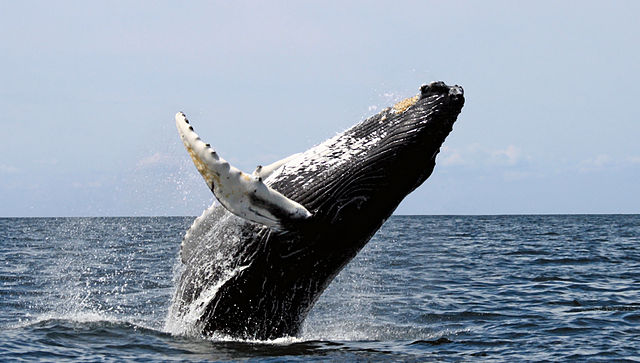Canada News
Fisheries Department says more staff on waters to protect Canada’s whales

Adam Burns, director general of fisheries resource management, said the number of officers deployed to keep people and boats away from the marine mammals has yet to be determined. (Photo By Whit Welles Wwelles14 – -, CC BY 3.0)
VANCOUVER — New regulations to protect whales, dolphins and porpoises are in effect for all coasts in Canada as the Department of Fisheries and Oceans works to ensure more officers and patrol vessels are available to enforce the rules.
Adam Burns, director general of fisheries resource management, said the number of officers deployed to keep people and boats away from the marine mammals has yet to be determined.
Extensive consultations with the whale-watching industry indicated support for the regulations in order to keep the animals in areas where tourists flock to see them, he said.
As of Wednesday, people and vessels must maintain a minimum distance of 100 metres from most whales, dolphins and porpoises to protect them from human disturbance, which is now more clearly defined to include feeding the marine mammals, swimming with them, removing them from their group or going between a mother and its calf.
At least 400 metres must be maintained from threatened or endangered whales, dolphins and porpoises in the St. Lawrence Estuary, a critical beluga habitat.
A distance of 200 metres is required to protect those marine mammals in the Saguenay-St. Lawrence Marine Park in Quebec, and the same distance must to kept from killer whales, including the endangered southern resident orcas, off B.C.’s coast.
In parts of the Church Estuary and the Seal River in Manitoba, people and vessels are required to stay at least 50 metres from the belugas that frequent the area in summer, Burns said, adding that will also allow for safe boating.
The Fisheries Department will use a combination of public education and penalties to enforce the regulations, which up to now have been voluntary guidelines.
The Pacific Whale Watch Association, which represents over 30 members in Canada and the United States, has said its operators voluntarily imposed 200-metre viewing limit on southern residents last year and slowed their vessels in known whale areas to cut noise.
The association has requested that the previous 100-metre viewing distance remain for the up to 850 transient, northern and offshore killer whales that are also present in West Coast waters.
However, Burns said it’s a challenge to tell the difference between killer whales in the water.
“The 200-metre approach distance is applied to all killer whales to ensure that that protection is in place in particular for the southern resident population,” he said, adding the regulations are supported by scientific studies suggesting the distance will help reduce noise and vessel interference with whale foraging activities.
The distance aligns with the current American limit of 200 yards, about 183 metres.
Christianne Wilhelmson, executive director of the Georgia Strait Alliance, one of four environmental groups that participated in consultations, said it has taken over a decade to come up with the recommendations despite mounting scientific evidence, which now suggests 400 metres would better protect southern resident orcas.
“Our federal government just dragged its feet for a very long time,” she said. “They just didn’t want to impose restrictions on any industry and finally they have because now we’re desperately in need of regulations to protect the orcas.”
Wilhelmson said the groups called on the Fisheries Department to close the chinook salmon fishery in January in key feeding areas, but the closure did not happen until June. Chinook is the favoured meal of resident killer whales.
The closure, that will last until the end of September, applies to parts of the southern Gulf Islands, portions of Juan de Fuca Straight and areas around the mouth of the Fraser River while the coast-wide harvest of chinook has been reduced by 25 to 30 per cent.
Paul Cottrell, marine mammals co-ordinator for the Fisheries Department’s Pacific Region, said the southern resident population has dwindled to 76 whales, and the regulations, along with the chinook closures, are intended to protect the endangered species.
He said Canada’s regulations, which apply to all cetaceans, have now gone beyond those in the United States because of their national scope on both the East Coast and the West Coast.
“This applies to humpback whales, grey whales, harbour porpoises and white-sided dolphins, and that’s not the case in the United States,” he said.
The regulations include the requirement to report to the Fisheries Department any incident of a vessel accidentally striking a mammal or when it becomes entangled in fishing gear, Cottrell said.
Under the Fisheries Act, anyone who disturbs marine mammals could be fined up to $100,000 or a maximum of $500,000 for a criminal offence, Cottrell said.





















